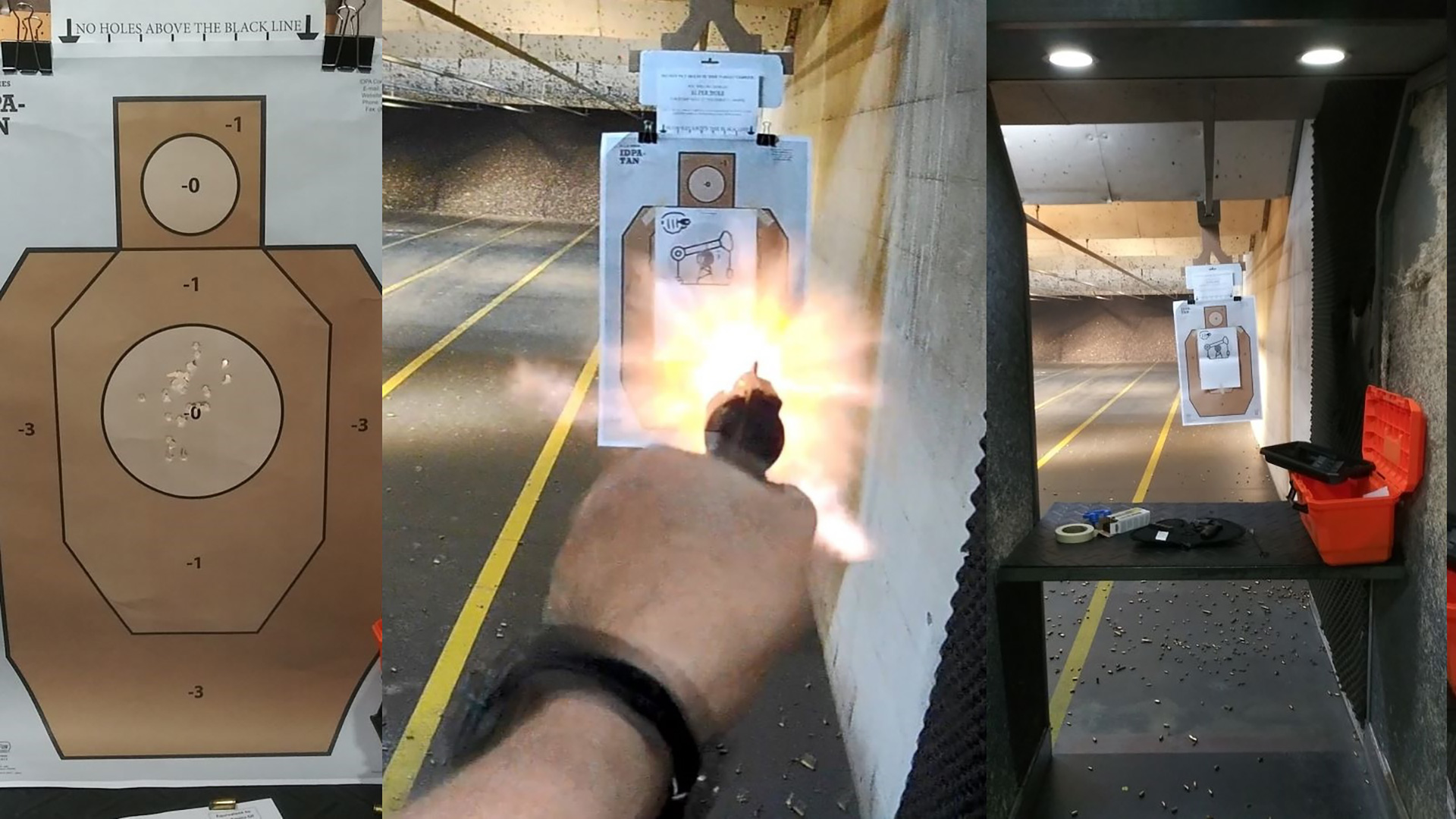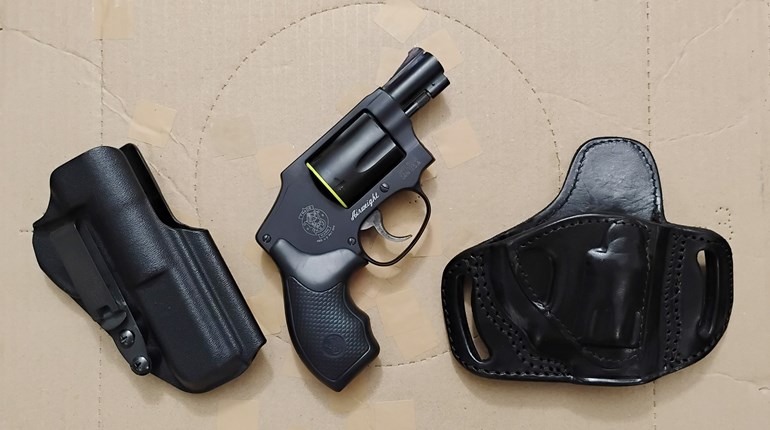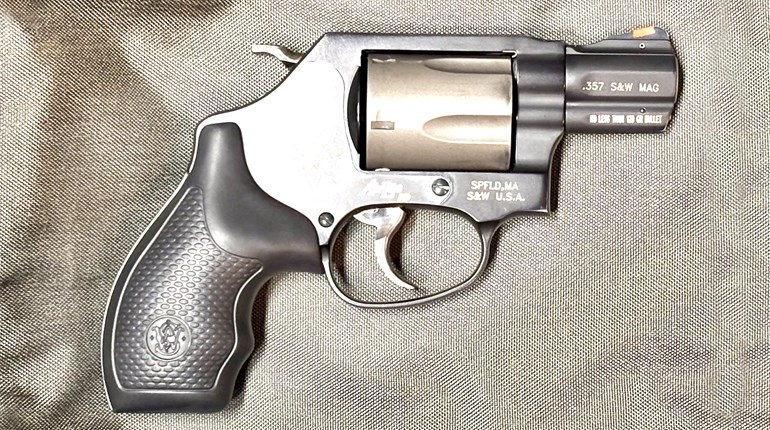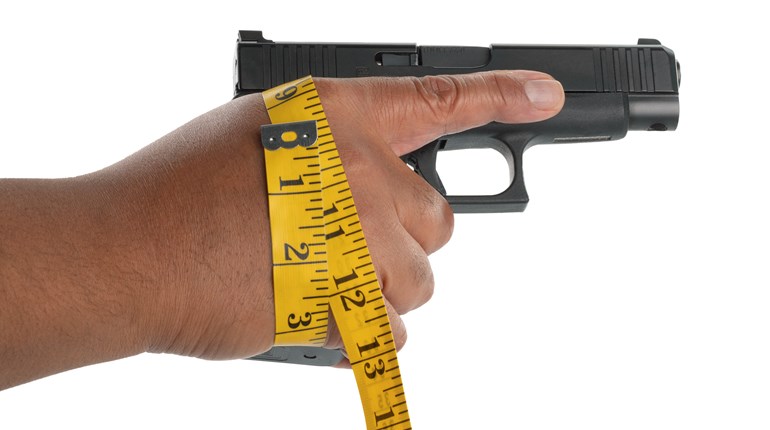
As we continue our journey of developing proficiency with a pistol, tightening up our standards is part of the exercise. We can look at this in several aspects: accuracy, speed and capability. Our accuracy standard can be tightened by simply using a target smaller than a full silhouette but still of relevant size. The New Mexico Concealed Handgun License Competency Demonstration gives us an excellent target for this purpose.
“(1) An applicant or licensee shall demonstrate competency in the safe use of each category and highest caliber of handgun for which he or she seeks certification by firing the handgun with live ammunition at a target no larger than 12 inches wide and 18 inches high.” --New Mexico Administrative Code 10.8.2.15B
Using a tabloid (11x17) piece of paper or two stacked sheets of letter-size (8½x11) paper in landscape mode handily meets this requirement. To further up the drill, we can put an 8-inch circle on the upper sheet.
Shooting The New Mexico Concealed Carry Test
The minimum course of fire is specified as “15 rounds from 3 yards and 10 rounds from 7 yards.” We can use this course of fire as a structure for improving our performance capabilities by breaking it into strings with just a few rounds per string and including shooting with only one hand.
Often, gun owners are concerned with practicing for ‘the worst possible case.’ There are many worst possible cases, with one chance being having one hand disabled (or otherwise occupied) in a gunfight. This could be either hand. If the support hand was disabled, we could simply drop the support hand off the gun and shoot with the primary hand.
If the primary hand was disabled, the situation becomes more complicated. Three situations could occur as a result. The first possibility is that the hand is shot before we are able to draw our gun and we are forced to draw with the support hand. This is a risky endeavor that should only be practiced dry using an inert pistol. We can practice live fire beginning with the pistol held in the low ready position, support hand only for the shooting part of the exercise.
The second possibility is that the primary hand is shot during the engagement and we can no longer fire it due to tendon damage but we don’t drop the gun. To practice this live fire, we would simulate it by beginning aimed at the target with both hands, transfer the gun to our support hand, and continue to shoot support hand only.
Finally, being shot in the primary hand might cause us to drop the gun. To compound the ‘worst possible case,’ it may land on the ground wrong side up and pointed toward us. In live fire practice, pointing the gun toward ourselves would be a serious safety violation so this should only be practiced dry with an inert pistol.
However, we can live fire practice for a wrong side up landing by placing the gun on the ground or bench with the primary side up and flip the gun over before picking it up. It would be picked up with the support hand and the shooting done support hand only.
 The three yard phase of the New Mexico Demonstration provides an excellent structure for practicing these upgrades to our performance capabilities. Using the required reduced area target gives us a gauge of how well we can accomplish these performance upgrades.
The three yard phase of the New Mexico Demonstration provides an excellent structure for practicing these upgrades to our performance capabilities. Using the required reduced area target gives us a gauge of how well we can accomplish these performance upgrades.
Three Yards – 15 rounds
- Load with 6 rounds (5 shot revolvers load with 5)
- With two hands
- Fire three shots from low ready
- Fire two shots from the midpoint of the drawstroke (five-shot revolvers reload with one (or two) round(s) afterward)
- Fire one shot from the holster or bench
- Load with six rounds (five-shot revolvers load with five)
- With the primary hand only
- Fire three shots from low ready
- Fire two shots from the midpoint (5 shot revolvers reload with one (or two) round(s) afterward)
- Fire one shot from the bolster or bench
- Load with three rounds
- Place the handgun in support hand
- Fire one shot from low ready support hand only
- Aim at the target with both hands
- Transfer the handgun to support hand only and fire one shot
- Place the handgun on the ground or bench primary side up
- Flip the pistol over, pick it up with the support hand only, and fire one shot
- Place the handgun in support hand
- With the primary hand only
- With two hands
New Mexico’s Performance standard is 72 percent, so 11 hits at 3 yards on the tabloid sheet would be the minimum we should accept. Having all 15 rounds hit the sheet is much more desirable.
Add In A Draw
If we add a draw, the 7-yard phase of the demonstration coincidentally mirrors the Los Angeles Police Department Retired Officer Qualification Course. This gives us the opportunity to do a qual within the settings of a police qualification. Bonus! The LAPD course requires the retired officer to draw and fire 10 rounds at a silhouette at 7 yards. Its required performance standard is 70 percent hits. By breaking the 10 shots into strings and adding a reload, our practice value is greatly enhanced. At ranges where drawing from a holster is not permitted, substitute a bench start.
Seven Yards – 10 rounds
- Load with five rounds
- Fire one shot from the holster or bench
- Fire two shots from the holster or bench
- Fire two shots from the holster or bench
- Reload with five rounds and immediately fire five shots
That’s 25 rounds of relevant practice, including at least one variation of the ‘worst possible case.’ At a minimum, shooters should hold themselves to the New Mexico standard of 18 hits out of 25 shots. Having all 25 rounds hit the 11x17 sheet is a better goal but might take a few tries to achieve with the one-handed shooting.
To further work on our accuracy enhancement, we can play a 20 round game with the NRA Basics of Pistol Shooting (BOPS) test. The minimum standard for Level One is to hit all five shots of a five shot string in a four inch circle at 10 feet, four times although not necessarily consecutively. For Level Two, the same drill is shot at 15 feet and for Level Three at 20 feet.
Basic Pistol Skills
Here’s the shooting game based on the BOPS tests. This makes the tests a little more interesting, fun, and challenging. It bears some similarity to the “walk back drills” often seen in tactical training classes. It’s even more fun when done by two shooters adjacent to each other as a challenge or contest.
 Place the target at 10 feet and shoot five shots. If all five shots hit the circle, move the target to 15 feet. If any shots miss the circle, keep it at 10 feet. Shoot five shots again on the next circle. If all the shots hit, move the target to the next distance, otherwise keep it at the same distance, and really concentrate on your sight picture and trigger press. Shoot the final five shot group at the distance you made all the hits to end on a positive note.
Place the target at 10 feet and shoot five shots. If all five shots hit the circle, move the target to 15 feet. If any shots miss the circle, keep it at 10 feet. Shoot five shots again on the next circle. If all the shots hit, move the target to the next distance, otherwise keep it at the same distance, and really concentrate on your sight picture and trigger press. Shoot the final five shot group at the distance you made all the hits to end on a positive note.
At 20 feet, shooters may need to use an adjusted point of aim to keep their shots within the circle. Not all fixed-sight pistols will shoot exactly to the point of aim at 7 yards. Even a 2-inch variation between point of aim and point of impact can cause the shots to miss the circle.
For example, this game was shot using a snub nose revolver. At 15 feet, the point of impact has diverged from the point of aim by over an inch. At 20 feet, the group had moved out of the circle. Adjusting the point of aim to the right and up yielded much better results for the final group.
Upgrading our standards of accuracy and capability serves us well in preparing for a possible defensive gun use. Knowing we can hit accurately and deal with one ‘worst possible case’ is a confidence-enhancer that every shooter deserves.




































